Yes, granted, it's actually Monday. But it was only a technical glitch that kept me from posting this yesterday, so it still counts as Sunday Chess Problem!
We're going to stick with endgame studies for this week. This one was composed by a fellow named Seletsky in 1933. It's white to play and win:
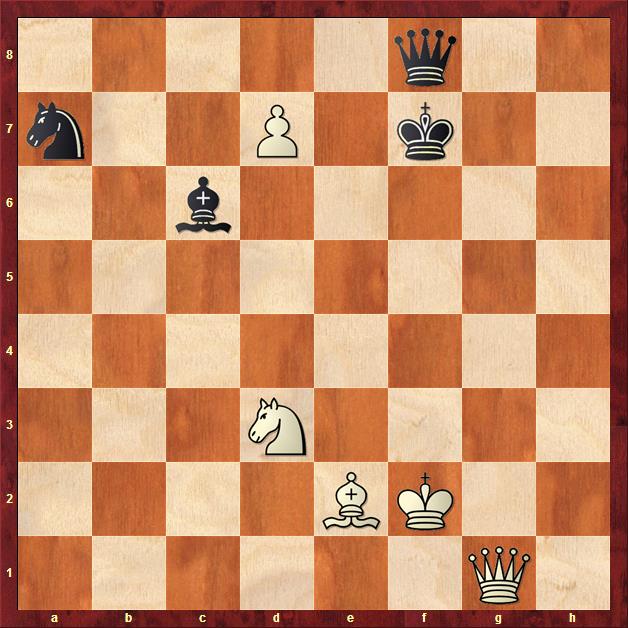
That's a lot of firepower on an open board! At first blush it seems that white's only advantage is his passed pawn on d7. But that little fellow is firmly under control. It turns out, though, that white has a mating attack. He will have to sacrifice his pawn, bishop, and queen to bring home the point, but the mate is there (unless black just gives up his queen or something). I should warn you that there are a fair number of side lines to consider in the early part of the study. I'll just indicate a few items, but you might want to have your computer analyzing in the background as you play through it. My admiration for this study increases when I keep in mind that Seletsky did not have a computer to help him with the analysis.
Let's see how the trick is done. White starts with 1. Qg5!, which threatens to promote the pawn. Now, taking the pawn does not work. We will have 1. ... Bxd7 2. Nf4 Qd6 (best) 3. Bc4+ Ke8 4. Qg8+ and the attack will prove to be too strong. Black's best is 1. ... Ke6+, and white must carefully select a square for his king. It turns out that 2. Kg1!, is the only way to shield the king from annoying checks later in the study. And now, after 2. ... Kxd7 we have reached this position:
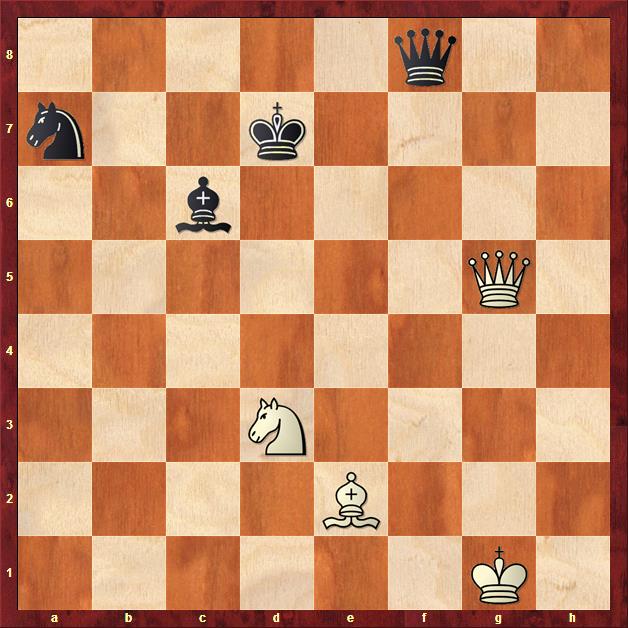
Taking with the bishop is again unsuccessful. 2. ... Bxd7 3. Bg4+ Kf7 4.Ne5+ Ke8 5. Bxd7 mate. Now we have 3. Nc5+ Kc8:
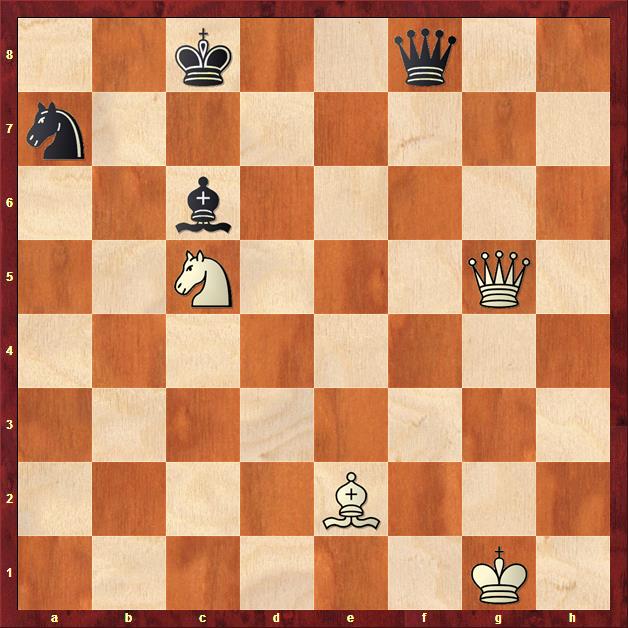
Black could not play 3. ... Kd6 because of 4. Qg3+ Kd5 5. Bc4+ Kxc4 6. Qb3+ Kxc5 7. Qa3+, which wins the queen. The resulting endgame of queen against two pieces is a theoretical win.
OK. Now things settle down a bit and the play is more forcing. We have 4. Ba6+ Kb8 5. Qg3+ Ka8:
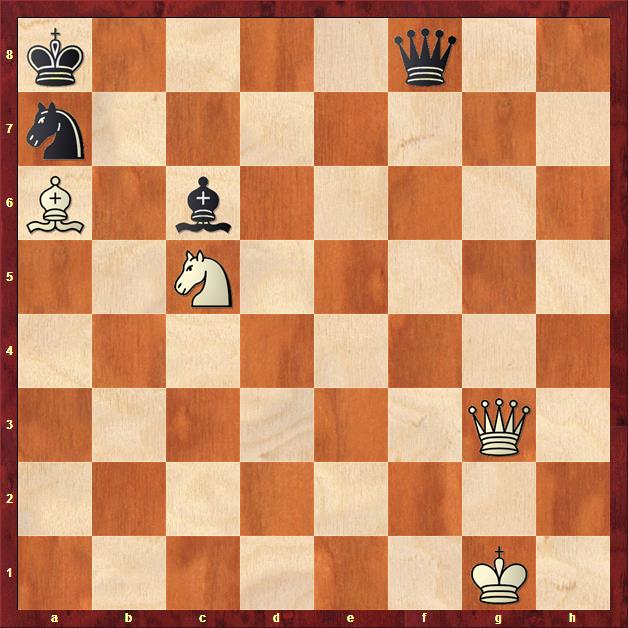
The black king is getting kicked around a fair amount, but hasn't he found safety at last? No! Now we have the dramatic finale. 6. Bb7! Bxb7 7. Nd7! White's clever second move has ensured that black has no checks. That means he must move his queen, and 7. ... Qd8 is as good as anything.
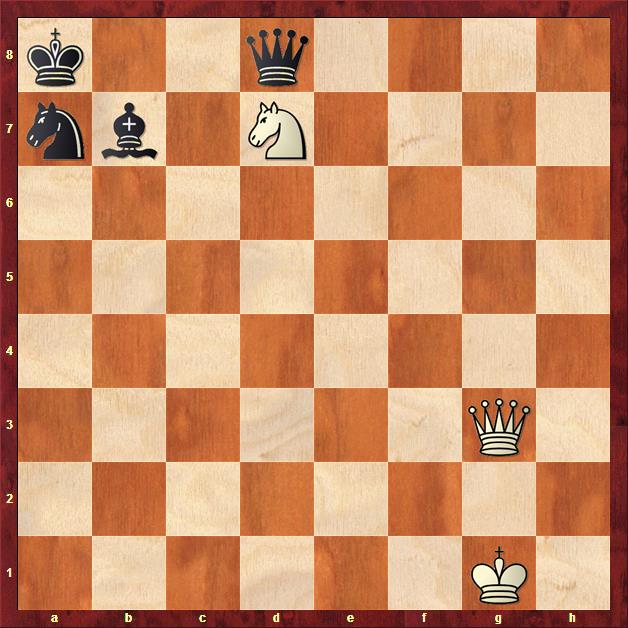
But I'll bet you see the finish now. It's a classic smothered mate after 8. Qb8+ Qxb8 9. Nb6 mate.

Pure wizardry! The large number of side lines early on might count as a small artistic blemish, but the skill with which the powerful black army is forced to do white's bidding more than makes up for it. Great stuff!
See you next week.
- Log in to post comments

After 1 ... Bxd7 White has a stronger reply in 2 Bh5+, which forces 2 ... Ke6+. After 3 Kg1 White is threatening mate with Qe5, so Black must prevent this somehow. There are a few tries:
- 3 ... Nc6 4 Bf4+ and now:
--- 4 ... Kf7 drops the bishop, leaving White with an easy win.
--- 4 ... Kd6 5 Qc5+ is even worse, since that drops the queen instead.
- 3 ... Bc6/Bb5 4 Bg4+ is mate in 5. There could follow:
--- 4 ... Kd6 5 Qe5#
--- 4 ... Qf5 5 Bxf5+ and even if you miss the mate we're a queen up.
- 3 ... Bc8 4 Bg4+ is much the same as the Bc6 line.
- 3 ... Qh8 4 Qe3+ and now:
--- 4 ... Kd5 5 Qc5+ and now if 5 ... Ke4 6 Bg6+ is mate in 4, while 5 ... Ke6 6 Nf4+ Kf6 7 Qd4+ snags the queen.
--- 4 ... Kd6 5 Qc5+ Ke6 is the same as the previous line.
--- 4 ... Kf5 5 Qc5+ is similar to the ... Kd5 line, except if now 5 ... Kf6 6 Qd4+ snags the queen.
--- 4 ... Kf6 5 Qe5#
- 3 ... Qf5 4 Bg4 pins and wins the queen.
- 3 ... Qb8 4 Nc5+ Kd6 5 Qg3+ wins the queen.
Still, that was with the benefit of modern computing technology, and 2 ... Nf4 is certainly still good enough.
Hmm. A daylight savings Monday study. I wonder... in a real game I think I might actually play the opening move in this after thinking maybe 15 minutes, since a couple of seconds suffice to realize that checks with the Knight or Bishop expose you to a discovered check, and ten or so minutes calculating tactics will not give you all of the results presented by Gazza above or Jason in the original analysis, but you'll have a positive "feel" that you are making a good play since you see so many threats to Black.
A minute or two more of reflection tells you that you are at least going to get the Black King to move more towards the center of the board, since no other move will prevent the pawn from queening on White's next move. Allow a couple more minutes to double-check that you didn't miss anything obvious, and you play it. My question is this: How long does it take chess engines these days to find the opening move? Ten seconds? (I try not to think about computer chess these days. I play one restricted to a 1500 rating sometimes just to noodle around while reclining on a couch.)
And yet, as Jason says, my admiration for the composer of these problems increases with the thought that he could come up with this without a machine.
Now for my point: as we merge with these machines as Kurzweil proposes in The Singularity Is Near and How To Create A Mind, will we regard a study like this as no big deal at all? I wonder.
I prefer to think more along Rudy Rucker's lines back in the early 80s in his Software novel, where he had robots freed from Asimov conventions peeling apart human brains to figure them out. But who knows?